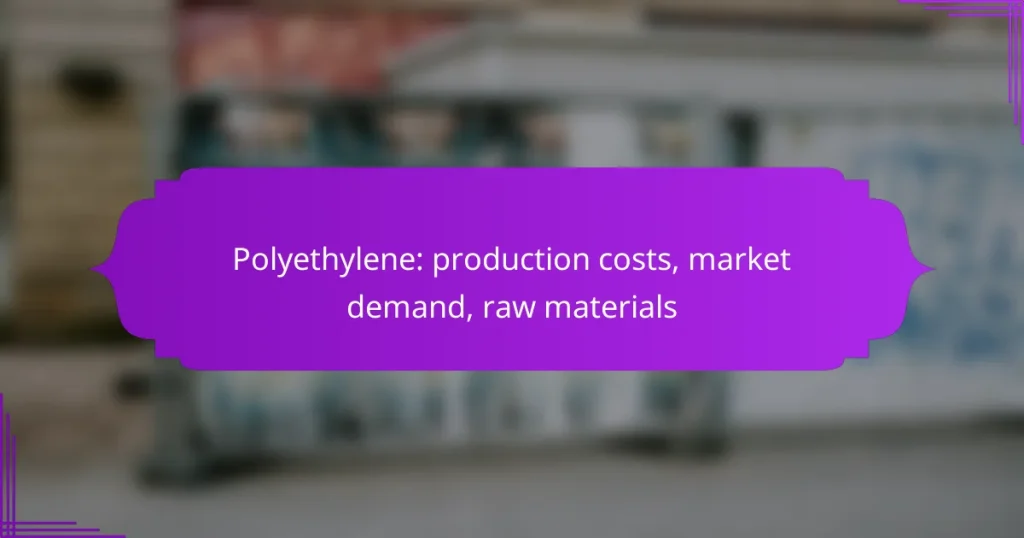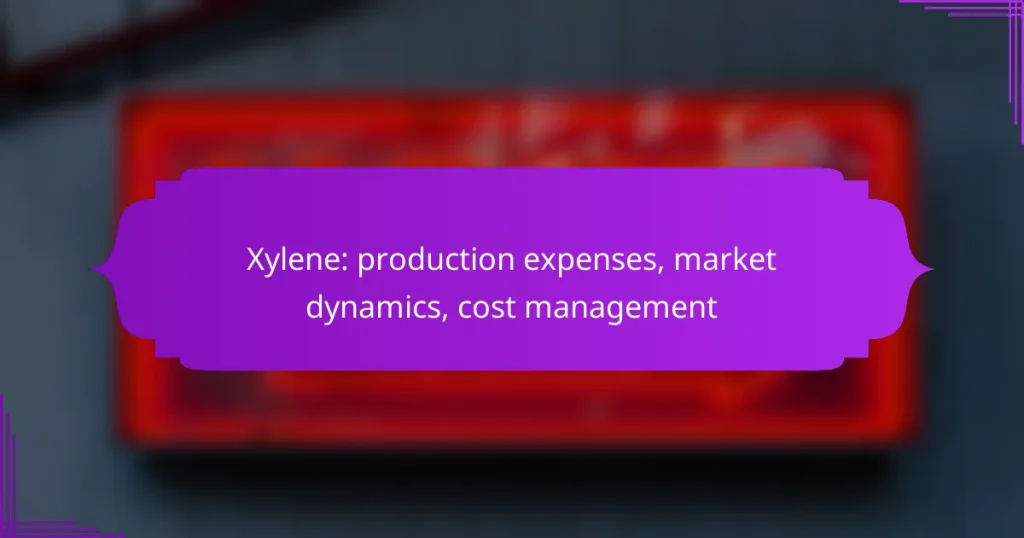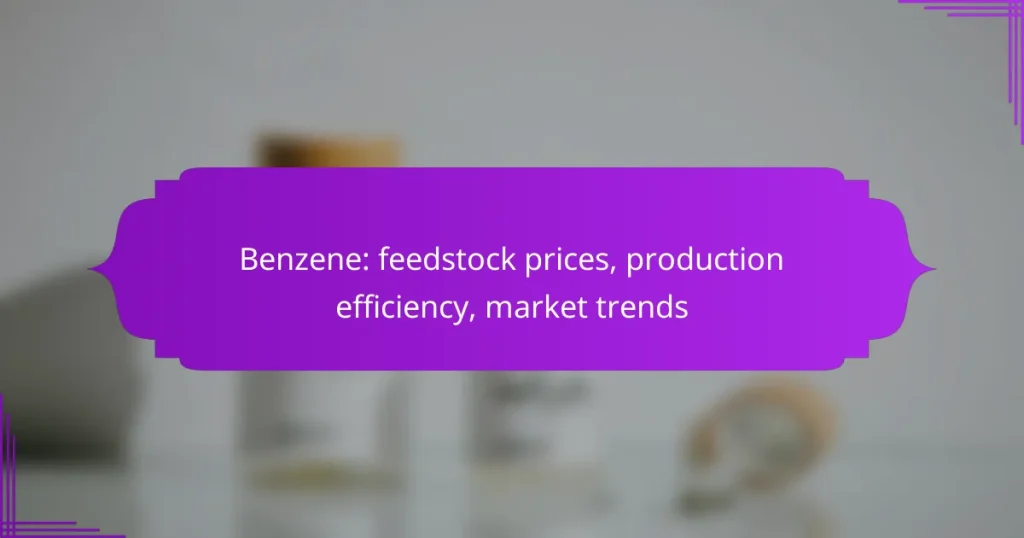Cost factors in petrochemical production are critical for maintaining competitiveness in the market, particularly in New Zealand. Key elements include raw material prices, energy expenses, labor costs, regulatory compliance, and transportation logistics. Understanding these factors is essential for managing production expenses and optimizing profitability.
Polycarbonate: manufacturing costs, market competition, pricing
Xylene: production expenses, market dynamics, cost management
Benzene: feedstock prices, production efficiency, market trends
What are the key cost factors in petrochemical production in New Zealand?
The key cost factors in petrochemical production in New Zealand include raw material costs, energy expenses, labor costs, regulatory compliance costs, and transportation and logistics. Understanding these factors is essential for managing overall production expenses and ensuring competitiveness in the market.
Raw material costs
Raw material costs are a significant component of petrochemical production expenses. In New Zealand, these materials often include natural gas, crude oil, and various chemicals. Prices can fluctuate based on global market trends, supply chain disruptions, and local availability.
Producers should monitor market prices and consider long-term contracts to mitigate risks associated with price volatility. Additionally, exploring alternative feedstocks can provide cost advantages and enhance sustainability.
Energy expenses
Energy expenses represent another major cost factor in petrochemical production. The energy required for processing can be substantial, with electricity and natural gas being the primary sources. In New Zealand, energy prices can vary significantly based on demand and government policies.
Implementing energy-efficient technologies and practices can help reduce these costs. Producers should also consider renewable energy options, which may offer long-term savings and align with environmental goals.
Labor costs
Labor costs encompass wages, benefits, and training expenses for the workforce involved in petrochemical production. In New Zealand, these costs can be influenced by local labor laws, skill availability, and industry competition.
Investing in employee training and development can enhance productivity and reduce turnover, ultimately lowering labor costs. Companies should also stay informed about changes in labor regulations that may impact expenses.
Regulatory compliance costs
Regulatory compliance costs arise from the need to adhere to environmental and safety regulations in the petrochemical industry. In New Zealand, these regulations can include emissions standards and waste management requirements.
Staying compliant often requires investment in monitoring systems and reporting processes. Companies should proactively engage with regulatory bodies to ensure they meet requirements while minimizing compliance costs.
Transportation and logistics
Transportation and logistics costs are crucial for moving raw materials and finished products. In New Zealand, geographic factors can impact these costs, especially for remote production sites or distribution to international markets.
Optimizing supply chain logistics, such as choosing efficient transportation methods and consolidating shipments, can help reduce expenses. Companies should also evaluate local infrastructure to identify potential cost-saving opportunities in their logistics operations.
How do raw material prices impact petrochemical production costs?
Raw material prices significantly influence petrochemical production costs, as they account for a large portion of total expenses. Fluctuations in the prices of feedstocks like crude oil, natural gas, and naphtha can lead to varying production costs, affecting profitability and pricing strategies.
Market volatility
Market volatility refers to the rapid and unpredictable changes in raw material prices. Factors such as geopolitical tensions, natural disasters, and changes in supply and demand can cause prices to spike or drop unexpectedly. For instance, a sudden increase in crude oil prices can lead to higher costs for petrochemical producers, impacting their pricing and production decisions.
Producers should monitor market trends and consider hedging strategies to mitigate risks associated with price fluctuations. Establishing long-term contracts with suppliers may also help stabilize costs and reduce exposure to market volatility.
Supply chain disruptions
Supply chain disruptions can significantly affect the availability and cost of raw materials in petrochemical production. Events such as transportation strikes, port closures, or pandemics can hinder the timely delivery of essential feedstocks. These disruptions can lead to increased costs as producers may need to source materials from alternative suppliers at higher prices.
To minimize the impact of supply chain disruptions, companies should diversify their supplier base and develop contingency plans. Maintaining adequate inventory levels can also provide a buffer against sudden shortages, allowing for continued production without significant cost increases.
What role does energy consumption play in production costs?
Energy consumption is a significant factor in petrochemical production costs, often accounting for a substantial portion of overall expenses. The type and amount of energy used can greatly influence operational efficiency and profitability.
Electricity pricing trends
Electricity prices for petrochemical plants can fluctuate based on market conditions, regulatory changes, and regional supply and demand. In many areas, these prices have shown an upward trend due to increased demand and the transition to renewable energy sources.
Producers should monitor local electricity pricing trends to optimize their energy contracts and potentially lock in lower rates. For example, negotiating long-term agreements during periods of low demand can help mitigate future cost increases.
Fuel source variability
The choice of fuel sources for energy generation can significantly impact production costs. Common fuels include natural gas, coal, and oil, each with its own price volatility and availability issues.
For instance, natural gas has become a preferred option due to its relatively lower emissions and cost-effectiveness in many regions. However, fluctuations in global oil prices can affect the overall cost structure, making it essential for producers to diversify their fuel sources to manage risks effectively.
How can labor costs be managed in petrochemical facilities?
Labor costs in petrochemical facilities can be effectively managed through strategic investments in automation and comprehensive workforce training programs. By optimizing these areas, facilities can reduce operational expenses while maintaining productivity and safety standards.
Automation technologies
Implementing automation technologies can significantly lower labor costs by reducing the need for manual labor in repetitive tasks. Technologies such as robotics, process control systems, and advanced data analytics can streamline operations and enhance efficiency.
For example, automated systems can monitor and control production processes in real-time, minimizing human error and downtime. Facilities that adopt automation often see labor cost reductions of 20-30%, depending on the extent of implementation.
Workforce training programs
Investing in workforce training programs is essential for maximizing the benefits of automation. Well-trained employees can operate sophisticated machinery and troubleshoot issues, which can lead to increased productivity and reduced reliance on external labor.
Training programs should focus on both technical skills and safety protocols to ensure employees are equipped to handle advanced technologies. Regular training updates can help maintain a skilled workforce, ultimately leading to better operational efficiency and lower labor costs.
What are the implications of regulatory compliance on costs?
Regulatory compliance significantly impacts costs in petrochemical production by necessitating investments in technology, processes, and reporting systems. Companies must allocate resources to meet environmental and health regulations, which can lead to increased operational expenses.
Environmental regulations
Environmental regulations often require petrochemical companies to implement measures that minimize pollution and manage waste effectively. Compliance may involve adopting advanced technologies for emissions control, which can be costly but necessary to avoid fines and legal issues.
For example, companies might need to invest in scrubbers or other filtration systems, which can range from tens of thousands to millions of dollars depending on the scale of production. Additionally, ongoing monitoring and reporting can add to operational costs, making it essential to budget for these expenses.
Health and safety standards
Health and safety standards are critical in ensuring worker safety and preventing accidents in petrochemical facilities. Compliance with these standards often requires training programs, safety equipment, and regular audits, all of which contribute to overall costs.
Investing in safety measures can lead to significant upfront costs, but it also reduces the risk of costly accidents and potential legal liabilities. Companies should prioritize regular safety assessments and employee training to maintain compliance and protect their workforce.
How does transportation affect overall production expenses?
Transportation significantly impacts overall production expenses in petrochemical production by influencing logistics costs, delivery times, and supply chain efficiency. Effective transportation management can reduce costs, while poor logistics can lead to increased expenses and delays.
Logistics optimization
Logistics optimization involves streamlining transportation processes to minimize costs and improve efficiency. This can include route planning, load optimization, and the use of technology for real-time tracking. By optimizing logistics, companies can reduce fuel consumption and labor costs, leading to overall savings in production expenses.
For example, using software to analyze traffic patterns and adjust delivery schedules can help avoid delays, which in turn reduces costs associated with idle time and late deliveries.
Local vs. international shipping costs
Local shipping costs are generally lower than international shipping costs due to shorter distances and fewer regulatory hurdles. Companies should evaluate their supply chain to determine if sourcing materials locally can reduce transportation expenses significantly.
International shipping often incurs additional fees such as tariffs, customs duties, and longer transit times. Understanding these costs is crucial for budgeting and can influence decisions on whether to import materials or produce them domestically.
What are the emerging trends in cost management for petrochemical production?
Emerging trends in cost management for petrochemical production focus on efficiency, sustainability, and technological innovation. Companies are increasingly adopting advanced technologies and sustainable practices to reduce operational costs while meeting regulatory requirements and consumer demands.
Sustainable practices
Sustainable practices in petrochemical production aim to minimize environmental impact and enhance resource efficiency. This includes using renewable feedstocks, reducing emissions, and implementing circular economy principles, which can lead to cost savings in the long run.
For instance, integrating carbon capture and storage (CCS) technologies can help companies comply with stricter emissions regulations, potentially avoiding costly penalties. Additionally, investing in energy-efficient processes can lower utility costs significantly, often by 10-30%.
To effectively implement sustainable practices, companies should assess their current operations and identify areas for improvement. Developing a clear sustainability roadmap and engaging stakeholders can facilitate this transition while ensuring alignment with market trends and consumer expectations.



